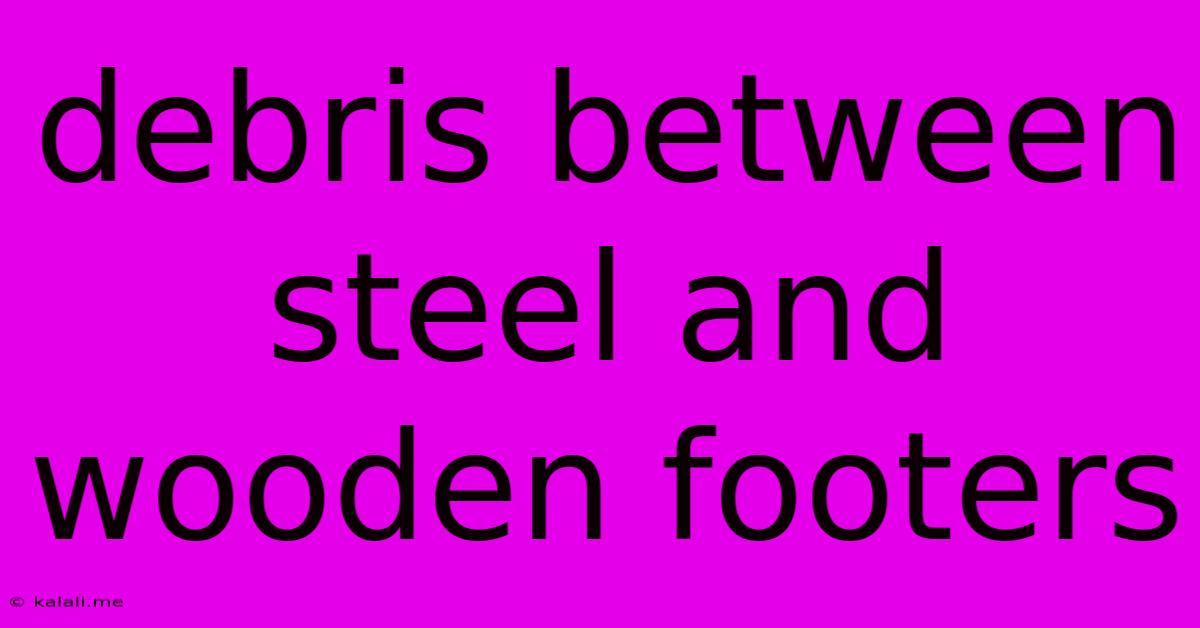Debris Between Steel And Wooden Footers
Kalali
Jun 01, 2025 · 3 min read

Table of Contents
Dealing with Debris Between Steel and Wooden Footers: A Comprehensive Guide
Meta Description: Discover the causes, dangers, and effective solutions for dealing with debris trapped between steel and wooden footers in your construction project. Learn how to prevent future issues and ensure structural integrity.
Dealing with debris trapped between steel and wooden footers is a critical aspect of construction and structural integrity. This often-overlooked detail can lead to significant problems if left unaddressed. This comprehensive guide will explore the causes, consequences, and effective solutions for managing debris in this crucial area.
Understanding the Problem: Why Debris Matters
The space between steel and wooden footers is a common location for debris accumulation. This debris can range from small stones and gravel to larger pieces of wood, concrete, and even construction waste. The presence of this debris creates several issues:
- Compromised Load Transfer: The primary function of footers is to transfer the weight of the structure to the ground. Debris acts as an insulator, preventing proper weight distribution and potentially weakening the entire foundation. This can lead to settling, cracking, and even structural failure.
- Corrosion: For steel footers, debris can retain moisture, accelerating corrosion and reducing the steel's structural strength. Rust weakens the steel, further compromising load-bearing capabilities.
- Pest Infestation: Debris provides an ideal habitat for pests like termites and rodents, which can damage both the wood and steel components, creating further instability and structural vulnerability.
- Moisture Retention: Trapped debris can absorb and retain moisture, leading to rot in the wooden footers and increased risk of mold growth.
Identifying Debris: Inspection and Detection
Regular inspection is crucial. Before pouring concrete, carefully examine the space between the steel and wooden footers. Use a flashlight and possibly a small mirror to thoroughly check for any debris. Consider using a small camera on a flexible rod for hard-to-reach areas.
Signs of potential debris problems might include:
- Uneven settling of the structure: Subtle sinking or tilting can indicate an uneven weight distribution caused by debris.
- Visible cracks in the foundation or walls: Cracks can be a symptom of underlying structural problems, including debris interference.
- Unusual sounds or creaks: Noises emanating from the foundation could be indicative of shifting caused by debris.
Effective Solutions and Remediation Techniques
If debris is found, immediate action is necessary. Here's how to tackle the problem:
- Manual Removal: For small amounts of debris, careful manual removal is often sufficient. Use appropriate tools like small shovels, brushes, and vacuum cleaners to clear the area thoroughly.
- Specialized Tools: For larger or more inaccessible debris, specialized tools such as air compressors or suction devices might be necessary. Always prioritize safety and wear appropriate personal protective equipment (PPE).
- Grouting: In some cases, grouting the space between the steel and wood footers can help fill gaps and prevent future debris accumulation. This should be done by a qualified professional.
- Replacement: If the debris has caused significant damage to either the steel or wooden footers, replacement might be the only viable solution. This is a more significant undertaking and requires expertise in structural engineering and construction.
Prevention: Best Practices for Clean Construction
Preventing debris accumulation is always better than dealing with it after the fact. Here are some best practices to incorporate into your construction process:
- Careful Site Preparation: Thoroughly clean the site before starting construction. Remove all loose debris and level the ground.
- Protective Barriers: Use barriers to prevent debris from falling into the space between the footers during construction.
- Regular Inspections: Implement regular inspections throughout the construction process to identify any potential problems early on.
- Proper Backfilling: Carefully control backfilling to avoid inadvertently introducing debris into the space between the footers.
By understanding the causes, consequences, and solutions related to debris between steel and wooden footers, you can build a more robust and stable structure. Remember that attention to detail and proactive measures are key to ensuring long-term structural integrity. Always consult with qualified professionals for complex situations or when in doubt about the structural safety of your building.
Latest Posts
Latest Posts
-
How To Fix Crack In Fiberglass Tub
Jun 03, 2025
-
Did Jesus Die On A Tree
Jun 03, 2025
-
When Do You Flip The Sign In Inequalities
Jun 03, 2025
-
Song Let It Go Demi Lovato
Jun 03, 2025
-
Can You Bring A Safety Razor On An Airplane
Jun 03, 2025
Related Post
Thank you for visiting our website which covers about Debris Between Steel And Wooden Footers . We hope the information provided has been useful to you. Feel free to contact us if you have any questions or need further assistance. See you next time and don't miss to bookmark.